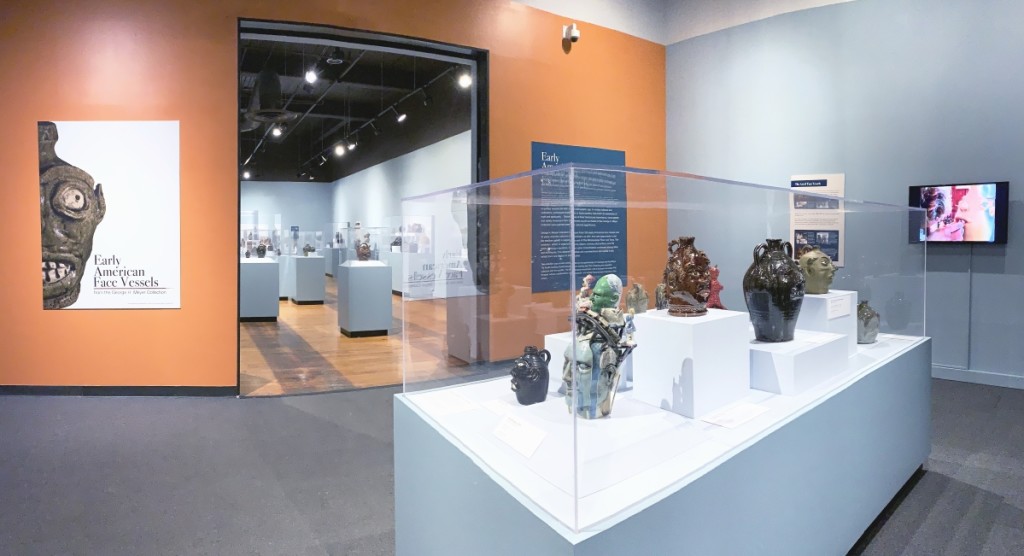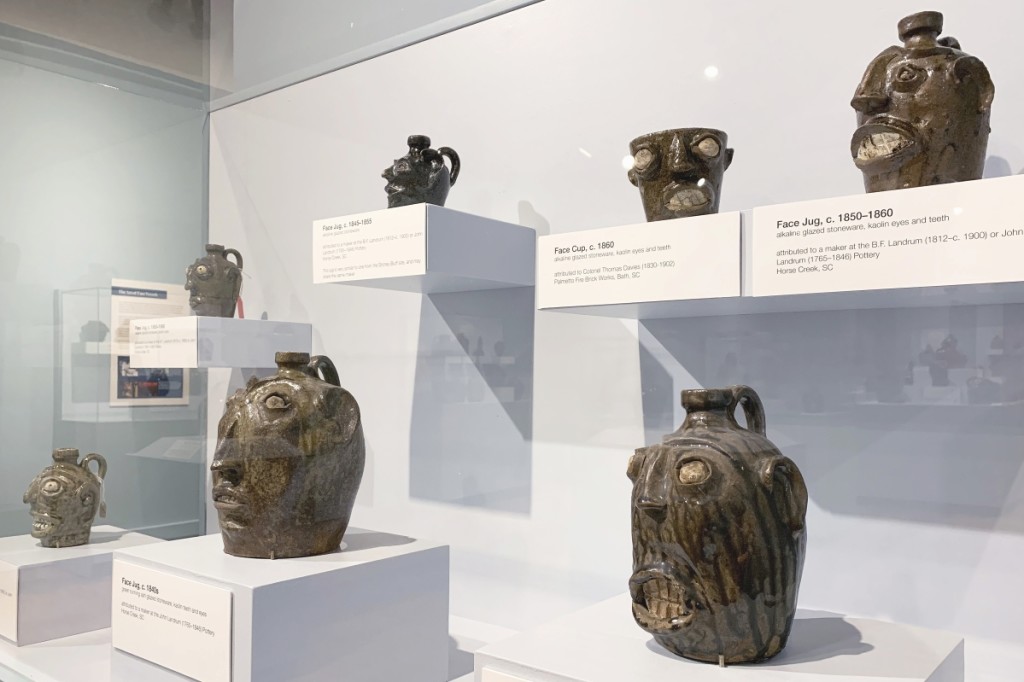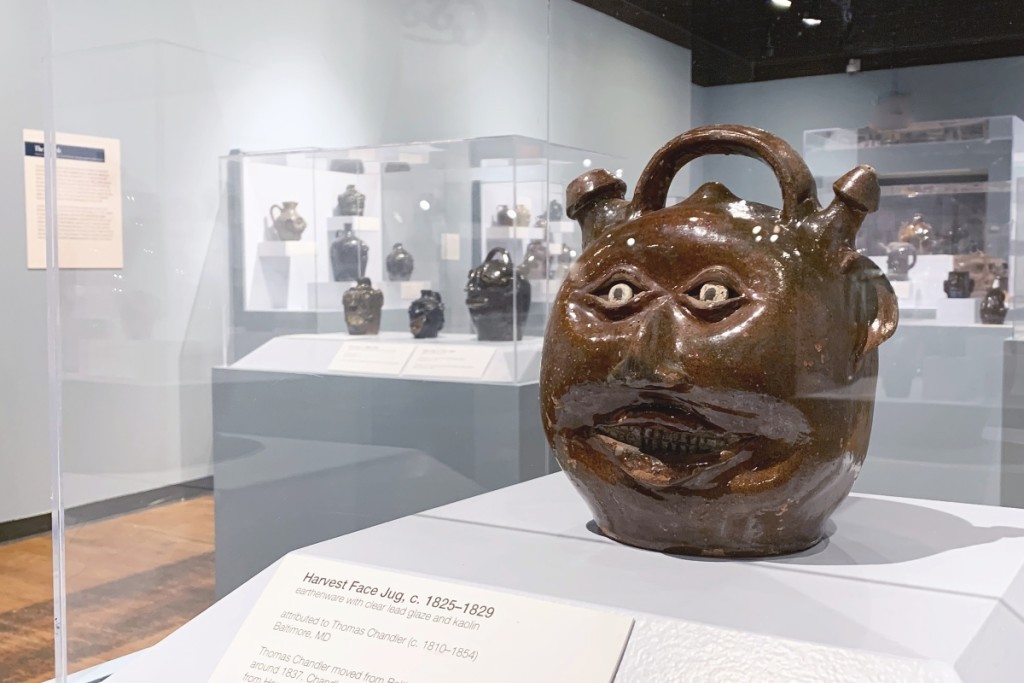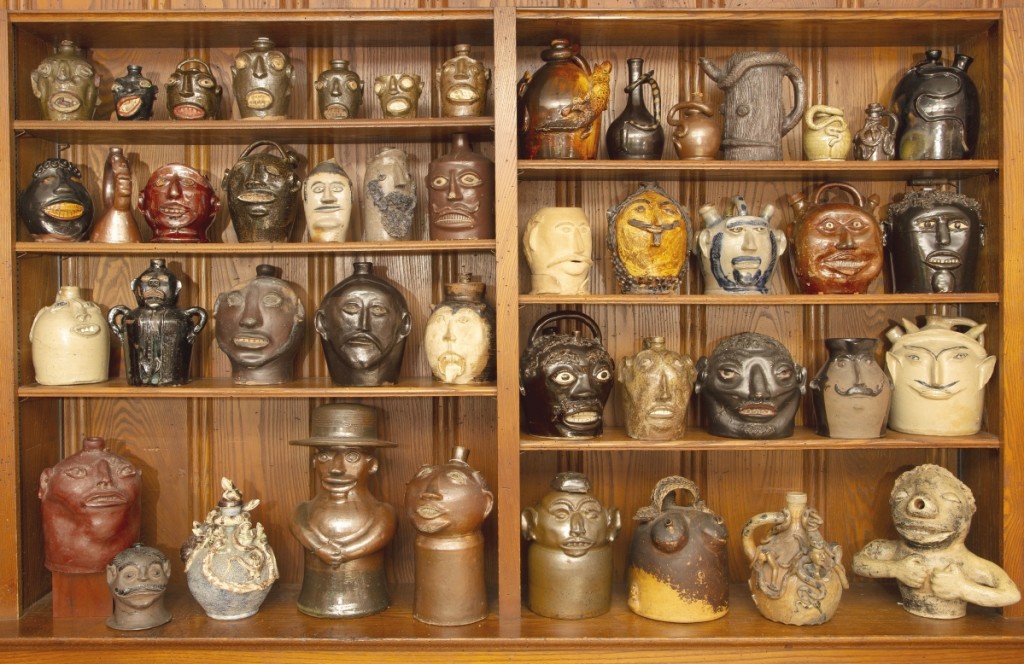We first spoke with George and Key Meyer in our June 28, 2019 issue on the occasion of the publication of their book, Early American Face Jugs, and the coinciding exhibition at the Fenimore Art Museum. The exhibition has now moved down to the South Carolina State Museum, where about 20 of the 100-plus examples are a bit closer to their birthplace of Edgefield, S.C. We sat down with the Meyers to talk about what is known of the Edgefield potters and, amid a booming market for early American face vessels, what it was like collecting them in earlier days.
Tell me how the collection found its way to the South Carolina State Museum.
K: The museum has a history of collecting and exhibiting historic South Carolina pottery and it was interested in the fact that face jugs represented a traditional art form that was present in the state. It was also a chance to see South Carolina potters and pottery in comparison with others from the whole Eastern United States. In addition, the museum has a large open gallery that permits a visitor to see all of the jugs at the same time and compare their differences and regional characteristics.
Do you own the largest face jug collection out there?
K: We believe it’s the largest, or certainly one of the largest, early American face jug collections. However, we believe there are some pottery collectors who also have a large number of contemporary examples.
G: I cut off my collection at 1950 in the belief that the format and design of face jugs changed about then.
Was Edgefield, S.C., the capital of Nineteenth Century face vessel production in the United States?
K: It was the epicenter of face jugs in the South, but there was a separate tradition on an independent trajectory in the North that descended from English and German potters of face jugs. If you look at our recent book and collection, one third are Northern jugs and two thirds are Southern. Thomas Chandler learned how to make face jugs in Baltimore from Henry Remmey before he picked up and moved to Edgefield, then a thriving pottery center. Chandler brought with him the face jug form, which the South Carolina African American slaves, who were working for white potters, then picked up and started to make their own. It is amazing how many Southern face jug makers can trace roots back to Edgefield. They spread out all the way to Texas, but their fathers or grandfathers all trained in Edgefield.
How did the potteries work?
K: Abner Landrum, a white physician, farmer and newspaper publisher, who had an important pottery in Edgefield and later in Columbia, S.C., was originally trained by an itinerant white potter. Many of those who set up pottery “factories” were trained by white potters, who would then train the African American slaves. Landrum initially wanted to make china starting around 1812 when there was an embargo of fine china coming from Britain. In trying to make it, he instead invented an amazing alkaline glaze based on Chinese recipes.
Do we know what the relationships might have looked like between the pottery owners and the enslaved?
K: The enslaved potted right alongside the white potters. Everybody worked, everyone was producing pottery, but there were some tasks that probably fell to the slaves. For example, in Edgefield, the wares had to be carted in some way to the river where they were distributed for sale. The slaves were also involved in the labor, digging up the clay, readying it and finding the glazes, while others were actually turning pots.

“Early American Face Vessels from the George H. Meyer Collection” is on view at the South Carolina State Museum through April 25, 2021. Image courtesy of the South Carolina State Museum.
Were the Edgefield potteries related to each other?
G: They intertwined. The potters all seemed to know each other and to share techniques and workers. Chandler used Landrum’s glazes. Dave, the enslaved potter, was passed around the different potteries. The influences were so strong between them. I always think of artists working alone in their attics, but these weren’t. They all were working very hard together to make a living as potters.
How impactful was slavery on the Edgefield area?
G: Almost all the Edgefield jugs seem to have an African American influence. We know they were not all actually made by slaves, but even the ones made by white potters were influenced by African American traditions. For example, the potters used kaolin to make the eyes, which made a very special kind of effect. Later potters usually painted the eyes. While enslaved, Dave Drake and Thomas Chandler, who was a white potter with his own place, made probably half the pottery that came out of Edgefield. They were turning things out all the time. If you take a Dave pot and put it next to one by Harvey Drake, one of his owners, you can’t tell the difference, both were really skilled and trained in the same way. Since these were small operations, these different owners and potters must have been quite involved with each other.
Were the owners well off?
K: The Landrums were financially well off. Chandler was well off, too. They all sort of went boom or bust. If you look at the inventories of the potters at the end of their lives, some were doing well and others were not. Even at their heyday, the pottery census listed at the most 15 employees. Maybe some of those were enslaved and the others weren’t. The potteries were not huge. Even though pottery was relatively cheap, if you sell a lot of it, you’re doing well.
Do you believe any of your jugs are by the same hand?
K: Some of them were made in the same place. Two examples are attributed to Mark Baynham Sr and Jr. These are a little later and were made by the same family at the very least. Some of the others, we think, were made by the same person. At the very least they were by the same pottery and they look alike, but since they were rarely if ever signed, we cannot be sure. For example, we own several jugs by B.F. Landrum and others by John Landrum. Potters in general were very itinerant, they would pick up when the clay ran out or would just move on. They were not making pottery necessarily all 12 months out of the year. When there was no demand, they would also farm or do other things.
Have they been able to number the early Edgefield potters?
G: By using archeological studies, scholars have been able to narrow down approximately how many potteries there were in the area. But to know how many people were making face jugs is impossible. There aren’t many written records.
Were face jugs commercialized?
K: We don’t believe the early ones were, but after the 1900s, yes. The vessels could have been sold in the community, but early on they weren’t made for tourists. It is believed potters made them as gifts or made them for somebody to have in their house.
Tell me more about their reason for being.
G: One theory is that they were an end-of-day special product made for spiritual reasons. The pottery owners knew they were being made since they all had to go in the kiln.
How do scholars know something is from the Miles Mills or Landrum potteries or any of the others?
G: Archeological research has turned up many sherds which give a picture of the output of a particular pottery. An author of an essay in our recent face jug book, Phil Wingard, has participated in a number of digs and was very helpful in identifying where some of our different Edgefield jugs were made. Part of the identifying characteristics may be the specific way a handle is made, or how an ear is formed. Also the glazes can be distinctive. All these little details add up to help to identify the location where a jug was made.
What’s your favorite piece of Edgefield in the collection?
K: Mine is the very smallest one, a bisque example with kaolin eyes and teeth that’s only 2-3/8 inches high. It’s just so cute, so little. When we wrote American Folk Art Canes: Personal Sculpture, we noted the connection when you hold a cane and think about who carved it and then who used it. With pottery there is the same tactile connection. You think who made this and what did they do with it? Edgefield jugs had overtones of magic and of being used in a messaging and spiritual way. The vessels speak to you.
G: One of my favorite objects in the collection at the museum is a large Pennsylvania water cooler which has been in our family room for many years. It has a presence and is a dramatic piece of sculpture. I miss it being present as part of our family.
Your friends that don’t collect, what do they think of your collection when they see it at your house?
K: They range from those who think the jugs are simply ugly to those who are fascinated by them. A lot of people don’t think they’re attractive, but I thought that was one of the strengths of George’s collection. Some of these are really refined portraits, while others are highly imaginative.
Let’s talk about your collecting journey. Who did you work with to put the collection together?
G: Mostly Ohio dealer David Good. He was the first one we knew who had a number of examples of early face jugs. One day David visited us at home and showed us several face jugs. He said he didn’t know a lot of about them. Then the next time I saw David, he knew much more. This was in the 1980s. I think he should be given a lot of credit for recognizing the art in face jugs long before they were popular. After a few visits with David, we were captivated by the face vessels.
What was it like buying in the 80s?
G: Much happier. Most of those that we bought were bought some time ago. They were not that expensive; a few hundred dollars would buy one. Not necessarily the best one, but one. Really good examples were generally in the low thousands. It was a real pleasure to find them because no one else that we knew was seriously buying them. We could buy good early face jugs fairly reasonably until the word got out. Then like any purchase of antiques, you wish you bought more back then.
K: Most face jugs were sold privately back then and we didn’t find them at auction often.

A selection of Edgefield face vessels is seen here together in the exhibit at the South Carolina State Museum. Image courtesy of the South Carolina State Museum.
Did you have to sell your cane collection to move into jugs?
K: No, unfortunately. It’s very hard to pry something out of George’s hands. He loves the things he has. We live with his collections and he often notes the empty shelves where the missing face jugs on loan to the museum used to be.
When did the market pick up on them?
G: Fairly recently, maybe ten years ago. Certainly the large prices today are well beyond what we were paying when we first started collecting.
What was it like collecting these pieces while the veil was being lifted on them through research?
K: Because people weren’t very interested in them, there was an awful lot of guesswork in the early days. There were so few of them in one place that they couldn’t really make a story. But from the 1990s onward, people got more interested in the pottery and potters of Edgefield and started doing some of this research. The interest in African American traditions in the United States has grown, and with that a new point of view. Folk art has always been a place that has valued African American artists and George began as a folk art collector, he recognized that early face jugs had been produced by really good artists.
When did early face jug production taper?
K: About ten years after the Civil War, the African American potters sort of disappeared. The potters we have collected from then on, in general, were white. These are some of the mysteries, what happened to these people? Making face jugs is a living tradition that was passed from white potters to African American potters and then back to white potters, and sometimes it’s hard to trace all of the reasons why.
And what of the Northern examples?
K: Many people know there were face jugs made in the South, but there was a a number of potters who made them in the North, particularly in Ohio. The Midwest potters seem to have stopped making them after a period of being very prolific. Prohibition, as a whole, may have put an end to this as we believe many of these examples were meant to hold liquor.
G: Not as much as we would like. For instance, in Ohio, we know the names of many of the potters and where they worked but we don’t know why they started or stopped making the face jugs. There’s a lot of unanswered questions in this field., and that’s fun too.

Seen here is the book’s cover image, a face jug attributed to Thomas Chandler made some time between 1810 and 1854. Earthenware with clear lead glaze and white painted details, 10 inches high. Image courtesy of the South Carolina State Museum.
Do you have any plans with your collection?
G: Some pieces will remain in the family. Some of it will probably be donated to museums and some may be sold.
Are you excited about the newfound interest in face jugs?
G: Yes, we are particularly excited about this exhibit in South Carolina. It’s a fabulous show. They’ve given every object enough room and you can see most of the face jugs from all sides. The museum has particularly good panels to talk about the vessels. We understand the museum may have some seminars in the spring, and we hope to be there for some of them.
Ed note: The South Carolina State Museum is using the Meyer book as the catalog for the exhibition. Early American Face Jugs by George H. Meyer and Kay White Meyer is a hardcover, 204-page book with color photographs of over 100 ceramic objects by prize winning photographer, Charles Nairn. To order visit www.SandringhamPress.com. The price is $65 plus $7.50 shipping and handling.
-Greg Smith






